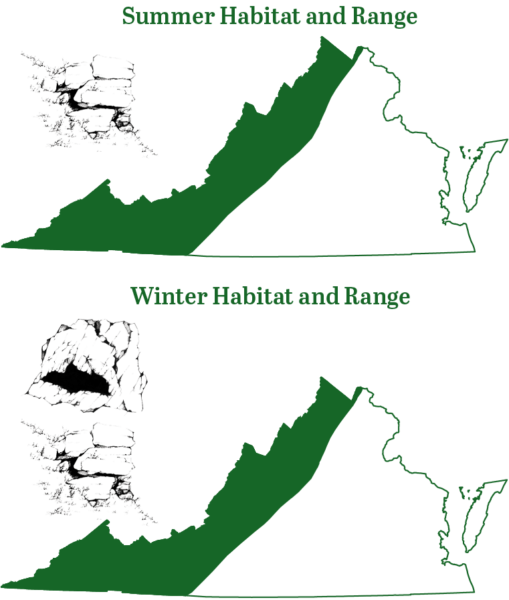Eastern Small-footed Bat. © Rick Reynolds.
Eastern Small-footed Bat. Illustration by Brittany Fernald.
Fact File
Scientific Name: Myotis leibii
Classification: Mammal, Order Chiroptera
Conservation Status:
- Species of Greatest Conservation Need-Tier 3a on the Virginia Wildlife Action Plan
Habitat
Small-footed bats hibernate in locations that are very close to freezing and can be found in caves, rock fissures, under large boulders, and in mud cracks in the floors of cave passages.
Diet
The feeding habits of the small-footed bat have not been extensively studied. These bats feed on flies, beetles, true bugs, leafhoppers, and flying ants and have been observed feeding while flying in slow erratic patterns less than ten feet above the ground.
Distribution:
The small-footed bat is found in the mountain regions of the western part of the state and is typically associated with rocky outcrops or boulder fields.

Reproduction
Little is known about the reproductive habits of this bat. It is believed that mating takes place before hibernation and that this is followed by delayed fertilization as frequently occurs in other Myotis species. Females form small maternity colonies in the spring, and it is thought that one pup is typically born each year, though twins occasionally are produced.
Conservation
Primary threat is white-nose syndrome. Protection of winter hibernacula and summer roosts (rocky outcrops, boulder fields, cliff lines, etc.) are conservation priorities.
Last updated: August 14, 2024
ShopDWR
Order your copy of A Guide to the Bats of Virginia, along with more gear, guides, and gifts!
Visit ShopDWRThe Virginia Department of Wildlife Resources Species Profile Database serves as a repository of information for Virginia’s fish and wildlife species. The database is managed and curated by the Wildlife Information and Environmental Services (WIES) program. Species profile data, distribution information, and photography is generated by the Virginia Department of Wildlife Resources, State and Federal agencies, Collection Permittees, and other trusted partners. This product is not suitable for legal, engineering, or surveying use. The Virginia Department of Wildlife Resources does not accept responsibility for any missing data, inaccuracies, or other errors which may exist. In accordance with the terms of service for this product, you agree to this disclaimer.

